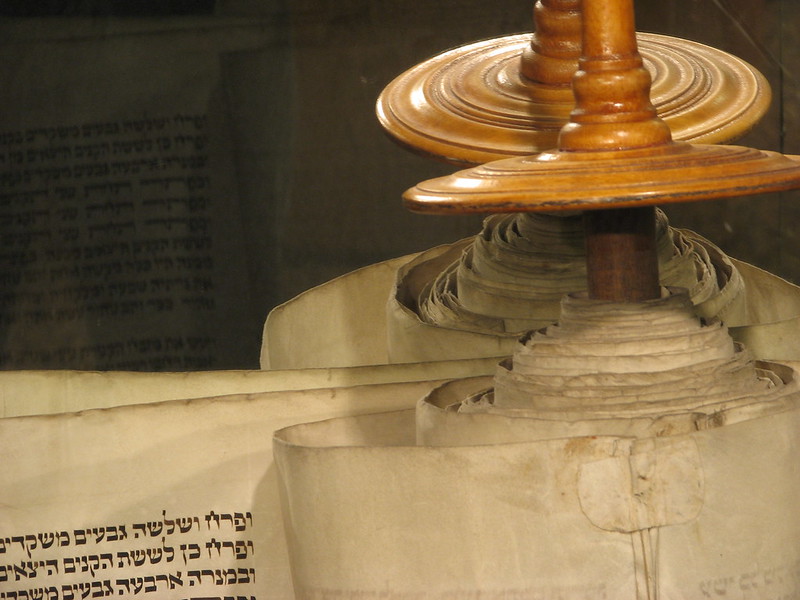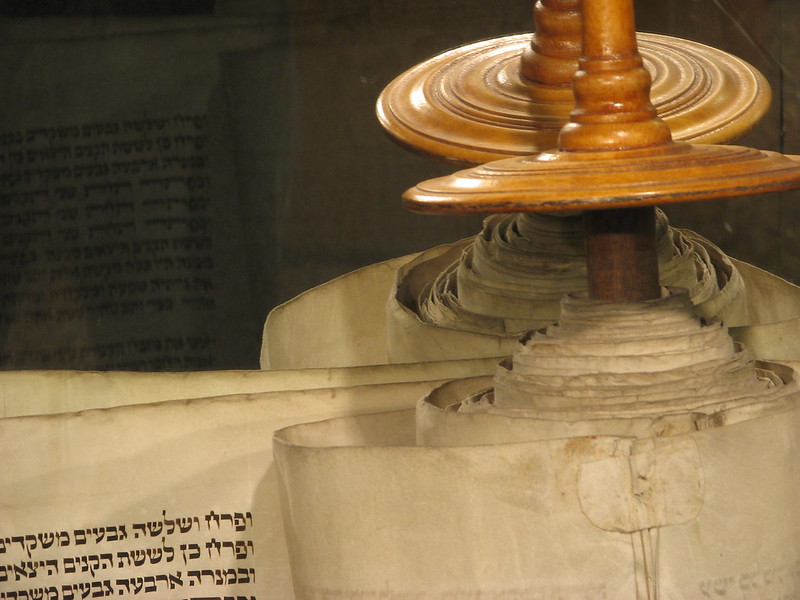
There’s no clear Mormon equivalent of a bat mitzvah. When I turned twelve in the 1980s, I stopped going to the Merrie Miss class in Primary and became a Beehive in Young Women’s. I traded the shouty chorus of “We are a Happy Family” and the mock-Indian gestures of “Book of Mormon Stories” for a Personal Progress book with its pearly white plastinated cover. Inside were printed instructions followed by straight blank lines to write out goals for growing in spirituality and strengthening my (current and future) family. Turning twelve is a little more public for boys: on Sundays they start carrying silver trays of bread and water around the chapel, passing the sacrament so members can renew their baptismal vows. But the laying-on-of-hands ritual that gives boys the Priesthood (and authority for a suite of male-only roles) is not a public ceremony.
Probably the closest thing I had to a bat mitzvah was my baptism when I turned eight. There wasn’t much preparation. I vaguely remember Bishop Worthington asking me into his office and checking I understood that now I’d be accountable for my own sins and responsible for my own repentance. Days later I dressed in a white dress my mother had sewn and met my father in the Church’s baptismal font – that strange little room with doors (and changing rooms) on both sides and those fake-wood hard plastic dividers (the same kind that separated the gym from the chapel) pushed open so friends and family could watch.
Two Priesthood holders looked down into the font, checking that my father nailed every word of the prayer and that I was completely immersed after “amen”. A floating skirt and a toe that popped up as I leaned back meant I had to be dunked three times before the requirements of the ritual were met and I became a member of the Church. Looking back, I was more an object on display than an actual participant. There is no scope for baptizees to open their mouths and share their thoughts.
So I was not prepared for the cerebral implosion I felt at my friend’s daughter’s bat mitzvah, where a confident young woman led prayers and expounded on scripture. Instead of a ten-minute formality of a baptismal interview, Ella had met with her rabbi and mentor for months. The rabbi remarked on Ella’s insights: her Torah passage covered exactly how priests should examine skin for leprosy, and she’d focused on how fear of disease divides communities, relating it to the isolation she and schoolmates experienced during the pandemic. My first thought was, wow, such wisdom from a 13-year-old. My next was, wow, such a religious leader: interested in what she has to say, delighted by her originality, ready to go where she led.
It was an impossible thing, the inverse of what I’d experienced as a Mormon youth. I hadn’t realized until that day that a bishop’s interview is a set of yes-no questions: the goal to assess your worthiness, not explore your thoughts.
The strangeness of the synagogue stirred strange emotions in me: the books that opened right to left, prayers in Hebrew with literary criticism printed in the margins, the formalized opening of cabinets to parade the Torah. I couldn’t stop the thought that all this could have been mine. My mother was born Jewish, but she’d converted to Mormonism when she married my father.
I tried to imagine myself growing up in a religion that embraces God as a grand mystery rather than one that demands belief beyond a shadow of a doubt, a tradition where exploration matters more than obedience, where questions are not an affront to authority.
During Ella’s ceremony, there was no mention of worthiness, temple marriage, children. Her religious leaders were not warning her to say on the straight-and-narrow covenant path but urging her to forge her own path. They wished her “a future of thoughtful risk-taking and open-mindedness.” I simply cannot imagine this coming from a Church leader, a celebration of individuality over conformity.
A few days later, an email thanked me for attendance. “After the Bat Mitzvah weekend and the prep for months,” Ella’s mother wrote, “I thought maybe Ella might feel some relief. Instead, she said to me, ‘I want another Bat Mitzvah!’” Yes, Ella, exactly.
Image credit: Flickr, J Nathan Matias

I attended an adult b’nei mitzvah class which included both men and women. We studied for months, learned multiple prayers and songs in Hebrew, learned enough Hebrew to read our Torah portion (and chant it appropriately) while following along with a yad.
It was a momentous event for all of us, both the Jews by choice and those raised as secular Jews who were “catching up” with the ritual.
I learned also that in Jewish congregations, Sunday School teachers all had degrees, so the kids weren’t “taught” by teachers simply reading out of the manual.
We had Torah Study on Saturday mornings as a voluntary class separate from services or the Sunday classes.
Before the b’nei mitzvah class, I attended a year-long class for converts. There was no baptismal challenge after two lessons followed by a quick dunk. We had to study for a year and show we understood enough about Judaism to make an informed choice. I remember sitting in my synagogue in New Orleans with ten other converts in class, thinking how there were more converts in this one room who’d all come of their own accord than there’d been converts to Mormonism in the city during that year.
And then, to my surprise, there WAS a baptism. My Reform congregation didn’t have a mikvah, so we went to an Orthodox synagogue, where I dunked myself. No one else was in the mikvah with me. The rabbi sat outside and directed me during the ritual.
Because I’m on public transportation, attending either in New Orleans or Seattle became too difficult, and my shift to atheism led me to no longer make the effort. But I very much enjoyed my time as a Jew, for exactly the reasons you point out.
Amazing post, Monya! The lack of thought and study required within Mormonism is glaring when compared to mainstream faiths. Of course, LDS Inc. has long touted their lay priesthood and overall lack of scholarship as superior, denigrating those faiths who require training for the ministry, much less membership. After all, study does tend to lead to critical thinking, open-mindedness, and (gasp) individuality. 😉
As an escapee from Mormonism, I really loved these posts. I came away with NO desire for any formal religion, but I do respect those who are true believers in kind/non-psychologically abusive religions (of which there are few). I cannot STAND the self-important, formally evangelistic churches. Mormonism certainly skirts the edges of that “way of worship”!
Thanks for your replies and for reading! I remember a treacly poem I wrote when I was 16 and my brother had just turned 12, and I was watching this little twerp* passing around the sacrament and being my way of reconnecting to Christ. Most is mercifully lost to time, but one phrase sticks in my head, “a vessel of great power.” Being female, my glory would be to bask in his. Yeesh.
Growing up Mormon left me with some life lessons I’m grateful for, but the so-ingrained gender roles is not one of them
*He grew up well
If your mother was born Jewish, you are aware that you are halchically Jewish, right? You could waltz into a synagogue tomorrow and have an aliyah (being called to the bimah, the “stage”, to read the Torah).
You write as if “what could have been yours”. I’ve got news: It is yours already if you choose to embrace it.
*halachically Jewish (Jewish by traditional, Rabbinic Jewish law). If you are interested in reclaiming your Jewish identity and culture many people stop at Chabad first because it’s so accessible. They represent one particular movement in Judaism though and don’t have a monopoly on it. Also explore the other shuls (synagogues) in your area, talk to people, and figure out which one resonates. Did I mention that talking and community is a huge part of the Jewish experience? It looks like you’ve picked up on that already – our prayer books have commentary and criticism printed in them.
??? Sorry for the typo and good luck. Shabbat Shalom. ???